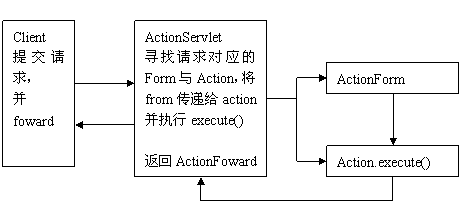Struts可以運行在任何一個支持JSP1.2和Servlet2.3的WEB Container中Struts將所有的請求提交到同一個中心控制器,org.apache.struts.action.ActionServlet 類
web.xml配置
<servlet-name>action</servlet-name>
<servlet-class>org.apache.struts.action.ActionServlet</servlet-class>
<init-param>
<param-name>config</param-name>
<param-value>/WEB-INF/struts-config.xml</param-value>
</init-param>
<load-on-startup>2</load-on-startup>
<servlet-mapping>
一個標准的使用了Struts的URL樣式如下:
擴展映射:http://www.my_site_name.com/mycontext/actionName.do
路徑映射:http://www.my_site_name.com/mycontext/do/action_Name
<servlet-name>action</servlet-name>
<url-pattern>*.do或/do/*</url-pattern>
</servlet-mapping>
Struts運行
Struts首先在Container啟動的時候調用ActionServlet的init()方法。初始化各種配置。這些配置寫在struts-config.xml文件中。
一個標准的struts-config文件包含如下結構:
<?xml version="1.0" encoding="UTF-8"?>
<!DOCTYPE struts-config PUBLIC "-//Apache Software Foundation//DTD Struts Configuration 1.1//EN" "http://jakarta.apache.org/struts/dtds/struts-config_1_1.dtd">
<struts-config>
<data-sources /> // 定義數據源
<form-beans /> // 定義ActionForm
<global-exceptions /> // 定義全局異常
<global-forwards /> // 定義全局轉向url
<action-mappings /> // 定義action
<controller /> // 配置Controller
<message-resources /> // 配置資源文件
</struts-config>
Struts由上述幾部分組成。其中最主要的是Action和Form。下面簡單敘述一下其處理過程。

一個請求提交給ActionServlet,ActionServlet會尋找相應的Form和Action,首先將提交的request對象,映射到form中。,然後將form傳遞給action來進行處理。action得到form,對xml的mapping,request,response四個對象,並調用execute()方法然後返回一個forward-url(相應視圖)給ActionServlet,最終返回給客戶端。
我們來看一個最簡單的實例
說明:實例一是最簡單的Struts程序。它僅僅使用了1個form和1個action功能是將首頁輸入的值傳遞給action,經過判斷後返回結果。如果是空則返回empty。代碼如下:
input.jsp:
<form method="post" action="/example.do">
請輸入值
<input type="text" name="test"/>
<br><br>
<input type="submit" name="Submit" >
<input name="reset" type="reset" >
</form>
struts-config.xml:
<struts-config>
// 配置formbean
<form-beans>
<form-bean name="exampleActionForm" type="com.zotn.struts.example1.ExampleActionForm" />
</form-beans>
// 配置action
<action-mappings>
<action name="exampleActionForm" path="/example" type="com.zotn.struts.example1.ExampleAction">
// action內部的foward
<forward name="foward" path="/foward.jsp" />
</action>
</action-mappings>
</struts-config>
Action:
public class ExampleAction extends Action {
public ActionForward execute(ActionMapping actionMapping, ActionForm actionForm, HttpServletRequest request, HttpServletResponse response) {
// 得到對應的form
ExampleActionForm eaf = (ExampleActionForm)actionForm;
// 取得輸入的test
String test = eaf.getTest();
// 判斷並將值放入request
if ("".equals(test)){
request.setAttribute("test","empty");
}else{
request.setAttribute("test",test);
}
// 通過mapping尋找相應的url,返回ActionFoward
return actionMapping.findForward("foward");
}
}
FormBean:
public class ExampleActionForm extends ActionForm {
private String test;
public String getTest() {
return test;
}
public void setTest(String test) {
this.test = test;
}
}